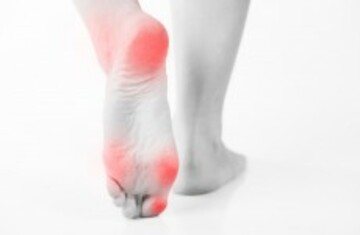THE DUBLIN MARATHON is rapidly approaching and we suspect that those planning on taking part are deep in training at the moment.
With the increased training load comes the greater likelihood of injuries and though some are unavoidable, so many more are.
Blisters on the soles of your feet fall into this category but we’ve sought the help of one of the country’s most well-known physios to help prevent these occurring.
Jenny Branigan has been at the finish line at the marathon in an official capacity for years so it’s fair to say she’s seen it all.
Here, we pick her brains about the dos and do nots of blisters – although reader discretion is advised!
Why do we get blisters on our feet/what causes them?
JB: Blister care and prevention are very important when training for an event. Blisters result from friction between your shoe or sock and your skin.
When concentrated pressure occurs, fluid builds up under the skin resulting in pain and swelling. If the friction ruptures little blood vessels you will develop a blood blister.
Runners often notice blisters when they race due to the increase in pace, swelling of their feet when get hot and sweaty, and with wet shoes from pouring water over their heads to cool themselves down.
Should you run on blistered feet?
JB: Running on a blister will make it larger and more painful. It is advisable to treat the blister before running on it.
How can you prevent getting them?
JB: If you have redness in the area without the bubble, you can prevent the blister further developing by applying a specialised adhesive blister plaster.
This will stick on and cushion the area, preventing further friction. If the blister bubble has already developed, it is advisable to pop it with a sterile needle and allow the fluid to gently drain out if it.
This will relieve the pressure and the pain. Applying cushioning, such as second skin, covered with a padded bandage will prevent infection and reduce pain. Never pull the skin off a blister, or you will end up with an open wound which will take much longer to heal and is more likely to get infected.
Any other tips for caring for our feet during periods of training?
- Cover the blister during the day to prevent infection
- Let the air at the blister at night when in bed
- Never pull the skin off the top of a blister – that skin protects the affected area
- Let specialized adhesive blister plasters fall off rather than pulling them off or you risk pulling the skin of the blister off with it
- Wear the correct socks – cotton socks retain moisture increasing the chance of friction and blisters. Choose synthetic socks that wick the moisture away from the skin and keep it fresh and cool
- Wear 2 pairs of well-fitting socks without creases
- Wear socks with reinforced heel and toe areas for added protection
- Wear the same socks and runners when you train and for the event itself- never wear new socks or shoes for a race
- Applying vaseline to your feet, then to your socks and then another layer of Vaseline onto the sock itself can prevent friction and blisters
- Make sure your shoes fit- if they are too big or too tight you will get friction between the shoe and your skin
- If you have any foot abnormalities such as bunions or hammer-toes, see your Chartered Physiotherapist for for help in managing these, as these can cause friction between the shoe and your skin causing blister
On a final note, look after your feet and allow them to recover after long runs. Elevate the legs when resting and soak them regularly in Epsom salts to keep the skin soft.
Jenny Branigan is a Chartered Physiotherapist, Pilates Instructor and owner of Total Physio in Sandyford. She is team physio for the Republic of Ireland Women’s National Team and appears regularly on national radio.








Ormond is a class act hopefully he gets a bit more recognition after this as he is not that well known.